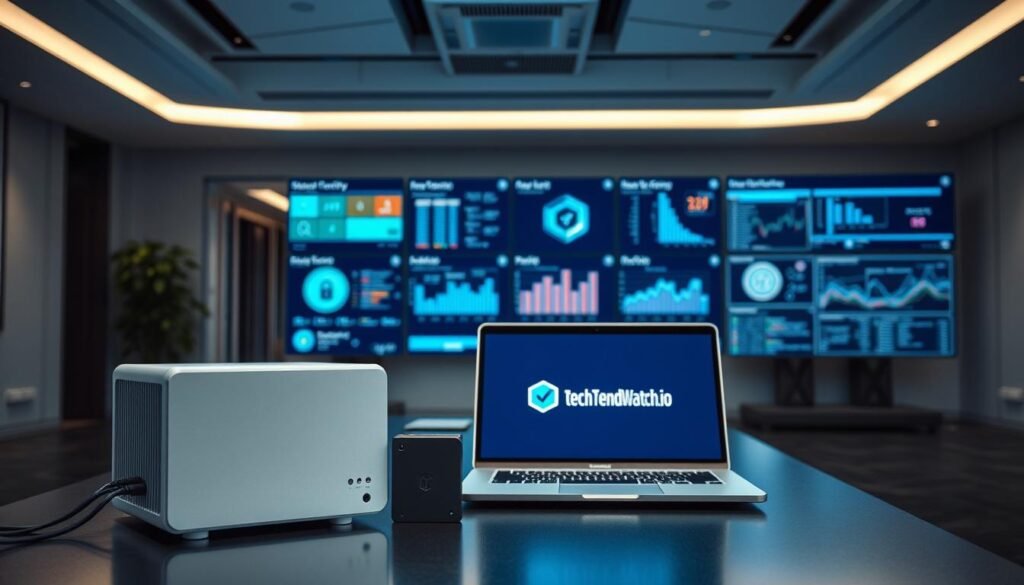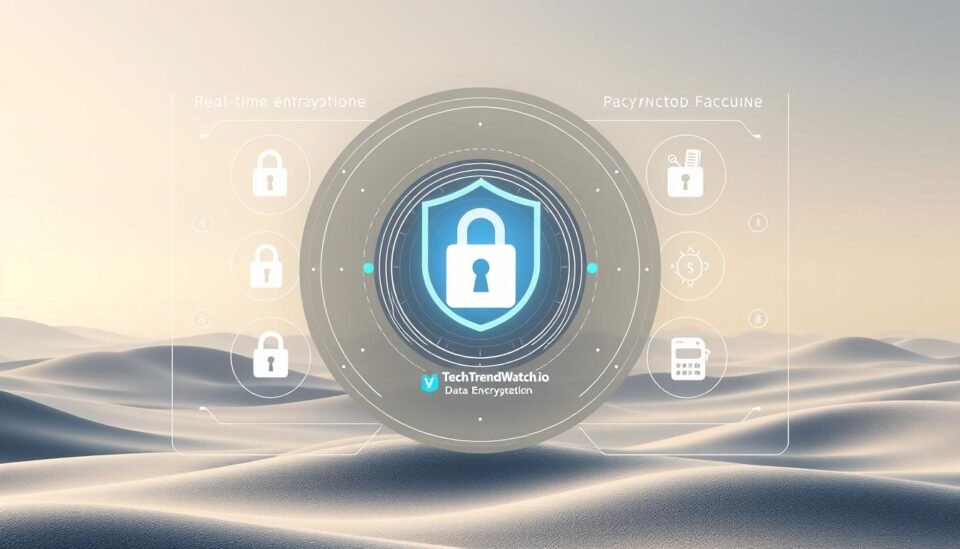What if your most sensitive details are just one click away from being exposed? In today’s hyper-connected world, businesses gather everything from email addresses to biometric scans—often without users realizing how vulnerable that information can become.
Protecting personal and business details isn’t optional anymore. With cyber threats evolving daily, relying on outdated methods could cost you financially and reputationally. Trusted tools like encryption and identity management systems are no longer luxuries—they’re necessities for anyone handling sensitive data.
Regulatory frameworks like the GDPR set clear standards, but compliance alone isn’t enough. You need strategies that blend user rights with technical safeguards. This guide cuts through the noise, offering actionable steps to secure everything from customer records to AI-driven workflows.
Key Takeaways
- Growing cyber threats demand proactive measures for safeguarding sensitive details.
- Actionable steps include encryption, identity management, and compliance alignment.
- Businesses face rising challenges in managing biometrics and other personal identifiers.
- Balancing user rights with technical controls ensures long-term security.
- Adapting to regulations like GDPR is critical for avoiding penalties.
Understanding Online Privacy & Data Protection
As our lives move online, protecting individual information rights is non-negotiable. Online privacy ensures people and organizations decide who accesses their details and how they’re used. Without it, trust erodes, and risks like identity theft or corporate breaches escalate.
Empowering Users Through Control
Modern tools let individuals manage what they share—and with whom. For example, apps now allow granular permissions for location tracking or photo access. Businesses adopting these practices build credibility while complying with laws like GDPR, which mandates transparency in data collection.
Defending Information with Technology
Encryption and multi-factor authentication act as digital shields, blocking unauthorized entry to sensitive details. A hospital securing patient records through encrypted databases illustrates this. Similarly, financial institutions use access controls to limit internal breaches.
Cyberattacks grow sophisticated yearly, but combining user-centric policies with advanced safeguards creates resilience. Aligning these strategies isn’t just about compliance—it’s about fostering lasting trust in a connected world.
Navigating Privacy & Data Regulatory Frameworks
Businesses operating across borders face a maze of rules dictating how they handle personal information. From hefty fines to operational shutdowns, non-compliance isn’t an option. Aligning with these frameworks isn’t just about avoiding penalties—it’s about demonstrating accountability in a world where transparency drives consumer trust.
Global Standards vs. Regional Requirements
The EU’s GDPR sets a high bar, requiring explicit consent for collecting details and granting users rights to delete or transfer their information. U.S. laws like CCPA and COPPA focus on specific sectors—children’s online activity or healthcare records—rather than a nationwide mandate.
For example, Epic Games faced a $520 million fine in 2022 for COPPA violations tied to default youth settings. Such cases highlight why companies must map their operations to regional laws. European rules prioritize proactive safeguards, while U.S. regulations often respond to breaches after they occur.
Organizations need clear policies that explain how they gather, store, and share user details. Regular audits and staff training ensure these practices stay current. Mixing technical controls with legal expertise bridges gaps between differing frameworks.
Understanding these structures isn’t optional. It’s the foundation of a governance strategy that adapts as laws evolve—and keeps businesses ahead of risks.
Implementing Privacy & Data Best Practices
In a world where trust is currency, businesses must prioritize ethical handling of user details. Clear communication and precise processes form the foundation of modern stewardship. Organizations that align operations with regulatory requirements not only avoid penalties but also strengthen relationships with stakeholders.
Securing Consent and Ensuring Transparency
Explicit user approval is non-negotiable when handling personally identifiable details. For example, healthcare apps now use layered consent forms explaining how biometric data will be stored. This approach meets regulatory requirements while fostering accountability.
Transparency goes beyond legal checkboxes. Retailers like Patagonia publish plain-language summaries of their collection methods. This builds confidence and reduces misunderstandings about how identifiable information supports services.
Maintaining Accuracy and Streamlined Lifecycles
Outdated records increase breach risks and operational costs. Regular audits ensure databases reflect current user preferences. A 2023 study found companies automating inventory updates reduced errors by 63% compared to manual methods.
| Lifecycle Stage | Action | Tool Example |
|---|---|---|
| Collection | Limit to essential fields | Form validation software |
| Storage | Encrypt sensitive fields | AES-256 databases |
| Retention | Auto-delete expired records | Data governance platforms |
| Disposal | Secure shredding protocols | Digital erasure tools |
Embedding privacy principles into product design minimizes future risks. Microsoft’s SDL framework mandates security reviews at each development phase. This proactive strategy turns compliance into competitive advantage.
Data Governance Strategies for Businesses
Effective governance transforms scattered efforts into a unified defense against breaches and mismanagement. By aligning policies with operational needs, organizations turn regulatory challenges into opportunities for building stakeholder confidence.
Collaboration Across Expertise Zones
Legal teams decode compliance requirements, while IT specialists implement secure storage systems. Cybersecurity experts identify vulnerabilities in real-time. Together, they create policies balancing accessibility with ironclad protection.
For example, a healthcare provider reduced breach risks by 78% after forming a cross-functional task force. Legal advisors streamlined consent forms, IT upgraded encryption protocols, and cybersecurity staff trained employees on phishing tactics.
| Team | Responsibility | Outcome |
|---|---|---|
| Legal | Regulatory alignment | Avoided $2M+ fines annually |
| IT | Storage infrastructure | 99.9% system uptime |
| Cybersecurity | Threat monitoring | 40% faster breach response |
Structured protocols prevent overlaps and gaps. A retail chain automated access controls based on employee roles—cashiers can’t view customer payment histories. This limits exposure without hindering operations.
Regular strategy sessions keep teams synchronized. Shared dashboards track progress on key metrics like incident rates and audit results. When expertise converges, governance becomes a competitive asset rather than a compliance burden.
Leveraging Technology for Data Protection
In the digital age, securing sensitive details requires more than just passwords—it demands cutting-edge tools. Over 60% of breaches involve compromised credentials, making advanced safeguards essential for modern enterprises. Let’s explore three pillars of defense every organization needs.
Encryption, IAM, and Access Controls
Encryption transforms readable information into coded text during storage and transmission. Banks use AES-256 encryption to shield financial records, while healthcare providers protect patient histories with TLS protocols. Identity and access management (IAM) systems add another layer by verifying user identities through multi-factor authentication.
Role-based access controls limit who can view or edit critical files. For example, retail companies restrict inventory databases to managers—not cashiers. This minimizes internal risks without slowing operations.
| Encryption Type | Common Use | Tool Example |
|---|---|---|
| AES-256 | File storage | VeraCrypt |
| TLS 1.3 | Data transmission | Let’s Encrypt |
| End-to-End | Messaging apps | Signal |
Backup Solutions and Disaster Recovery Planning
Immutable backups in cloud environments ensure information survives ransomware attacks. A 2023 study showed businesses using automated backups recovered 89% faster after breaches. Tools like Acronis Cyber Protect create unalterable snapshots stored across global servers.
“Disaster recovery isn’t about avoiding storms—it’s about building unsinkable ships.”
Regular audits and staff training keep defenses sharp. Companies like Adobe conduct quarterly penetration tests to identify vulnerabilities before hackers do. Pairing these strategies with scalable cloud solutions creates resilience against evolving threats.
Addressing Challenges with Generative AI and Data Privacy
Generative AI reshapes industries but introduces unseen vulnerabilities. When algorithms learn from proprietary inputs, they risk exposing confidential details through outputs. This creates complex security gaps where traditional safeguards fall short.

Managing AI-Driven Data Risks
Training models on sensitive information poses unique threats. Once absorbed, removing specific details from AI systems becomes nearly impossible. Samsung’s 2023 ChatGPT incident—where engineers accidentally leaked chip designs—shows how easily proprietary material can escape controlled environments.
Explicit user consent is critical. Organizations must explain how and why AI uses personal details. Opt-in processes should clarify if inputs train public models or remain private. For example, healthcare firms now use granular permissions for patient record analysis.
Regulatory scrutiny intensifies as laws struggle to keep pace. The EU’s AI Act requires transparency in training data sources, while U.S. sector-specific rules demand accountability. Non-compliance risks fines up to 4% of global revenue under GDPR.
| Risk | Solution | Tool Example |
|---|---|---|
| Data leakage | Input sanitization | AI content filters |
| Consent gaps | Dynamic disclosure forms | OneTrust |
| Regulatory fines | Compliance audits | SecureFrame |
Limit AI access to non-sensitive datasets where possible. Regular model audits and synthetic data generation reduce exposure. As one tech leader notes:
“Treat generative AI like a colleague—trust but verify every output.”
Privacy & Data Security Measures for Cloud Environments
Cloud systems offer unmatched flexibility but introduce risks when safeguards lag behind. Unlike traditional networks, shared infrastructure and remote access demand tailored strategies to prevent leaks and breaches. Organizations must balance scalability with ironclad protections that meet evolving technical and legal demands.
Optimizing Cloud Storage and Access Management
Granular controls ensure only authorized users interact with sensitive materials. For example, healthcare providers using AWS restrict patient records to specific roles through attribute-based policies. Automated backups paired with versioning protect against accidental deletions—a critical feature for GDPR-compliant systems.
| Security Measure | Purpose | Compliance Alignment |
|---|---|---|
| Role-Based Access | Limit exposure | GDPR Article 32 |
| Immutable Backups | Prevent tampering | ISO 27001 |
| Encryption Keys | Secure transmissions | CCPA §1798.150 |
Regular audits verify storage configurations match organizational requirements. Retailers like Target reduced breach risks by 42% after implementing quarterly access reviews.
Implementing a Zero Trust Architecture
This model assumes no user or device is inherently trustworthy. Each request undergoes strict verification, whether from inside or outside the network. Financial institutions adopting Zero Trust saw 67% fewer unauthorized access attempts within six months.
Continuous authentication replaces one-time logins. Tools like Okta analyze behavior patterns—unusual activity triggers additional checks. As one CISO noted:
“Zero Trust isn’t a product—it’s a mindset shift from ‘trust but verify’ to ‘never trust, always confirm.’”
Updating policies ensures technical measures align with regional frameworks like GDPR. Cloud-specific safeguards build resilience while maintaining stakeholder confidence in distributed systems.
Mitigating Risks and Preventing Data Breaches
A single misconfigured server could expose millions of records overnight. Proactive strategies blend advanced tools with disciplined processes to neutralize threats before they escalate. Organizations now prioritize layered defenses that adapt to evolving attack methods.

How DLP Tools Strengthen Defenses
Modern data loss prevention (DLP) solutions monitor interactions across networks and endpoints. They flag unusual activity—like bulk downloads of customer files—and block unauthorized transfers. Financial institutions use these systems to control access to transaction histories, reducing insider threats.
Effective implementation follows three core processes:
- Identification: Scanning systems to locate sensitive materials like credit card numbers.
- Classification: Tagging assets based on risk levels using AI-driven algorithms.
- Control: Automatically encrypting high-risk files or restricting sharing permissions.
Countries enforce distinct standards for breach management. The EU mandates notification within 72 hours under GDPR, while Australia’s Notifiable Data Breaches scheme allows 30 days. Canada’s PIPEDA requires organizations to report incidents that pose “significant harm.”
| DLP Solution | Key Features | Compliance Alignment |
|---|---|---|
| Symantec DLP | Real-time cloud monitoring | GDPR, CCPA |
| McAfee Total Protection | Endpoint threat detection | HIPAA, PIPEDA |
| Forcepoint Human-Centric | Behavioral analytics | ISO 27001 |
A 2023 case study shows a tech firm reducing breaches by 75% after deploying DLP tools with weekly policy audits. Regular staff training ensures teams understand best practices, like avoiding unsecured channels for sensitive communications.
Continuous refinement keeps defenses sharp. As one cybersecurity expert notes:
“DLP isn’t a set-and-forget tool—it’s a living system that evolves with your risk landscape.”
Building a Culture of Data Privacy and Security
Human error drives 88% of organizational breaches, making staff education the frontline defense against threats. Creating a security-first mindset requires more than annual seminars—it demands ongoing engagement that aligns with daily workflows and evolving risks.
Turning Knowledge Into Action
Effective programs blend interactive workshops with real-world simulations. For example, hospitals now run mock phishing drills where employees identify suspicious emails. Companies using monthly microlearning sessions see 52% faster threat recognition than those relying on yearly lectures.
Key components of impactful training include:
- Role-specific scenarios: Finance teams practice spotting invoice fraud attempts
- Gamified modules: Retail staff earn badges for completing security challenges
- Feedback loops: Anonymous reporting tools let workers ask questions without hesitation
Regular updates keep teams prepared for new attack methods. A 2023 study showed organizations revising materials quarterly had 67% fewer credential theft incidents. Aligning content with state compliance needs ensures training meets both legal and operational requirements.
Internal media channels reinforce these lessons. Tech firms like Cisco share breach case studies through company podcasts, while manufacturers use bulletin boards to display monthly security stats. This constant visibility makes protection part of workplace identity rather than an afterthought.
When security becomes cultural instinct rather than checkbox compliance, organizations transform their greatest vulnerability—human factors—into their strongest safeguard.
Preparing for Future Regulatory Changes in the Digital Era
Global compliance teams face 40% more regulatory updates annually compared to five years ago. Staying ahead requires agility as laws shift across industries and borders. Third parties like vendors and partners add complexity, making unified strategies essential for managing personally identifiable information (PII) responsibly.
Adapting Strategies for Evolving Requirements
Regional laws now target specific concerns. The EU’s upcoming AI Act restricts biometric data usage, while California’s Delete Act lets residents remove PII from multiple brokers at once. These changes force businesses to rethink how third parties handle sensitive details.
| Region | Key Law | Focus Area | Compliance Step |
|---|---|---|---|
| EU | AI Act (2025) | Algorithmic transparency | Audit AI training datasets |
| USA | California SB 362 | PII deletion rights | Update data brokers registry |
| Asia | India DPDP Act | Cross-border transfers | Encrypt PII during exports |
Monthly policy reviews help teams spot gaps early. A healthcare provider avoided fines by flagging outdated consent forms before new Colorado rules took effect. Collaboration with legal experts ensures technical controls match regional expectations in a connected world.
Proactive organizations build flexible frameworks. Automating PII classification cuts revision time by 58% when laws change. As one compliance officer notes:
“Treat regulations as living documents—what works today may fail tomorrow.”
Regular training prepares all parties for emerging concerns. Financial firms now simulate audits to test response plans. This approach turns compliance into competitive advantage in a fast-moving world.
Conclusion
Building resilience in safeguarding sensitive details is no longer optional—it’s imperative. This guide highlights how combining technical safeguards, transparent policies, and compliance alignment creates a multi-layered defense against modern threats. From encryption to cross-functional governance, every strategy serves one goal: balancing accessibility with ironclad protection.
Effective enterprise-level governance turns regulatory challenges into trust-building opportunities. By embedding best practices like automated audits and role-based controls, organizations reduce risks while maintaining operational agility. Prioritizing safeguards for personal health information and other identifiers isn’t just ethical—it’s foundational for long-term credibility.
Adapting to evolving data privacy regulations and AI advancements requires proactive planning. Regular policy reviews and staff training ensure teams stay ahead of threats like credential theft or algorithmic biases. Tools designed for data protection regulation standards, such as immutable backups and Zero Trust frameworks, future-proof systems against emerging vulnerabilities.
The importance of data privacy grows as digital landscapes shift. Businesses must treat security as a continuous process, not a one-time project. Whether safeguarding personal health information or aligning with global-level compliance demands, the call is clear: act today to secure tomorrow. Start by reassessing your strategies—because in this era, vigilance defines success.


